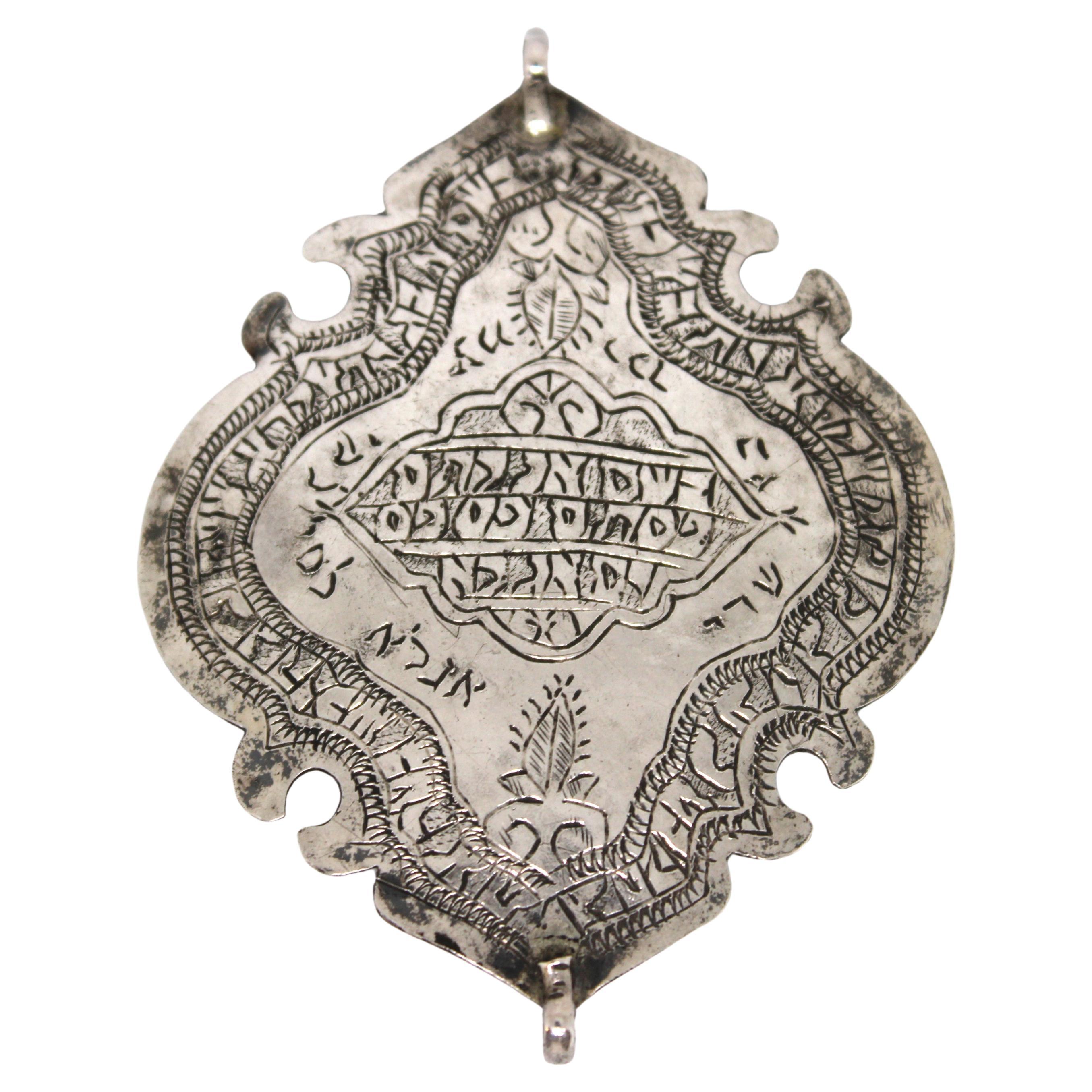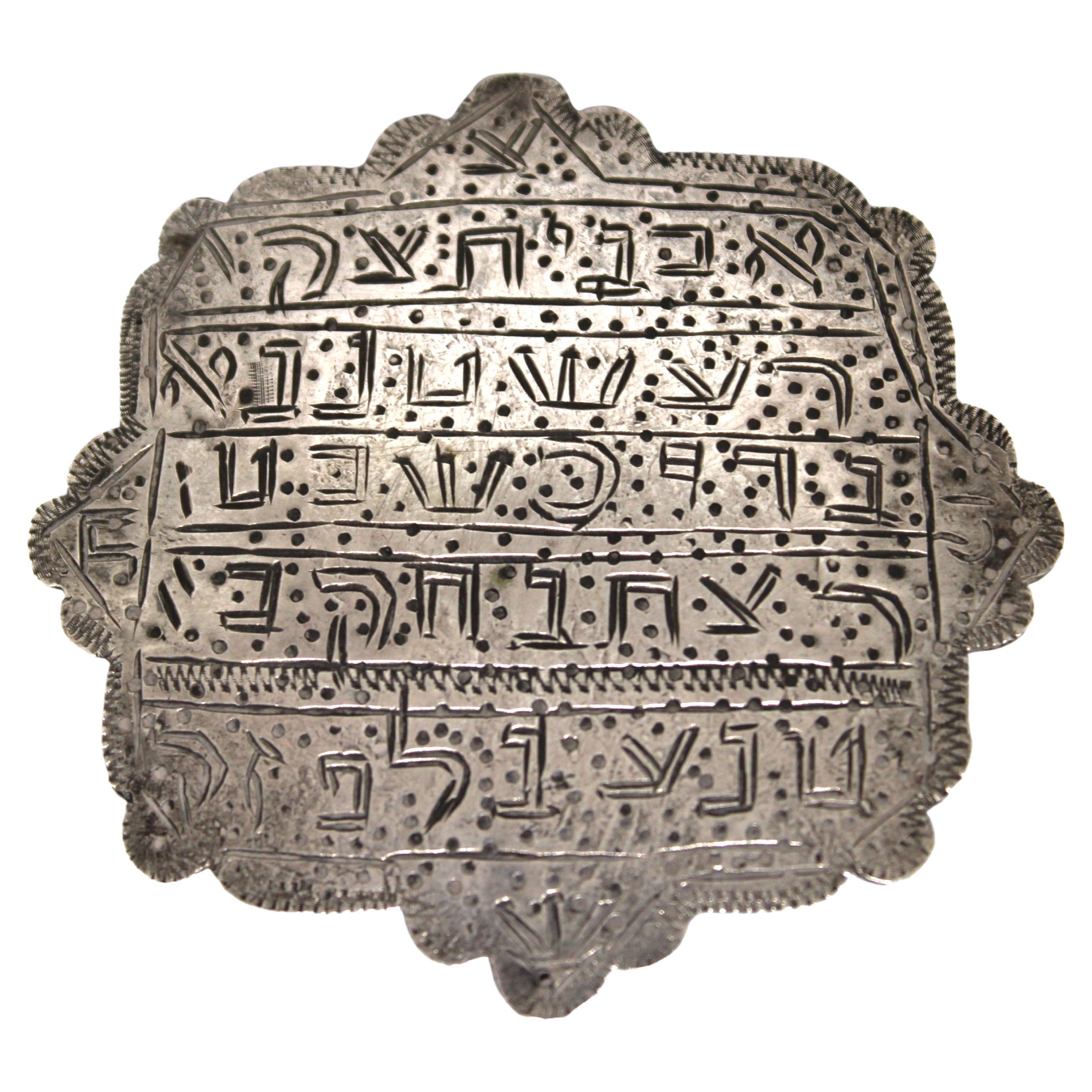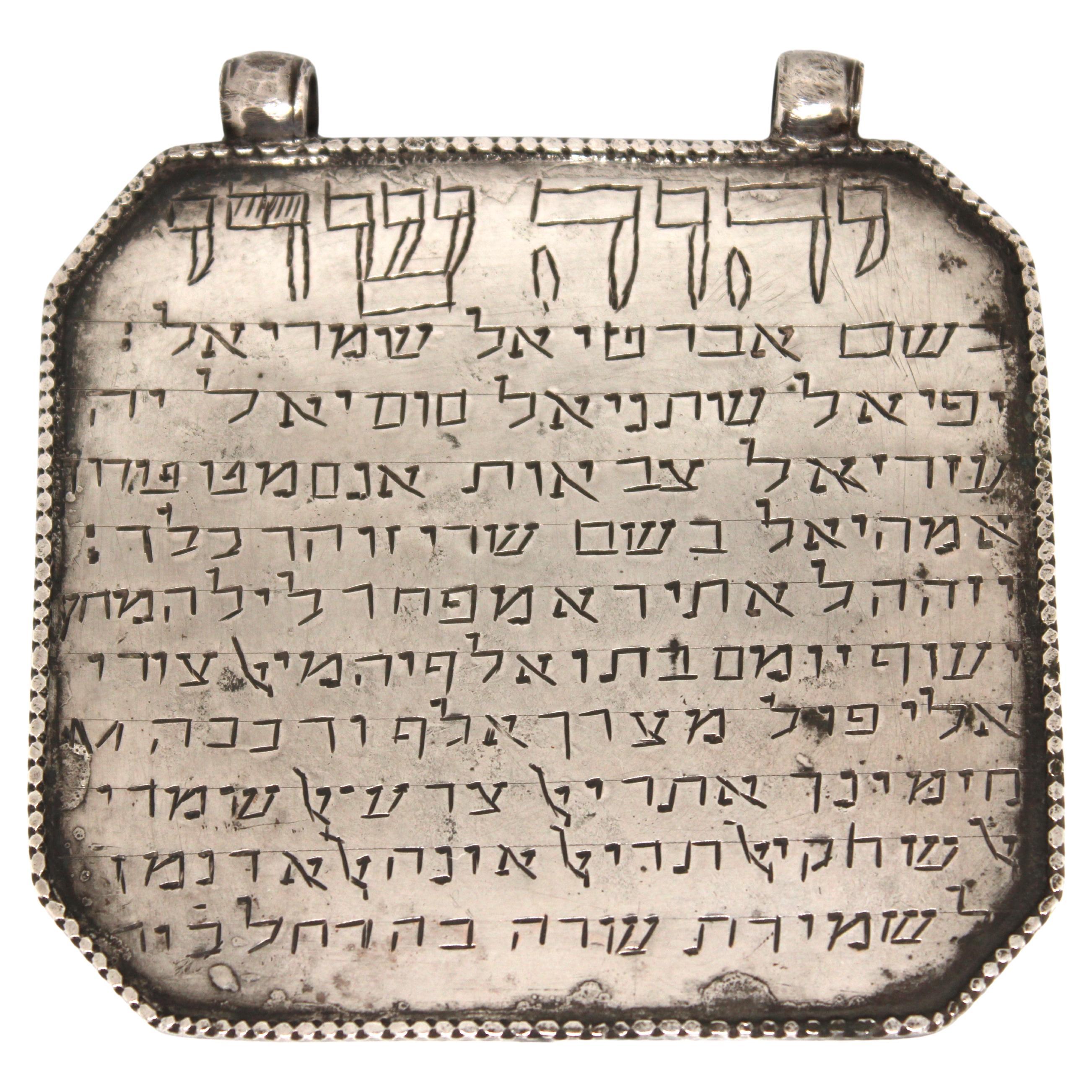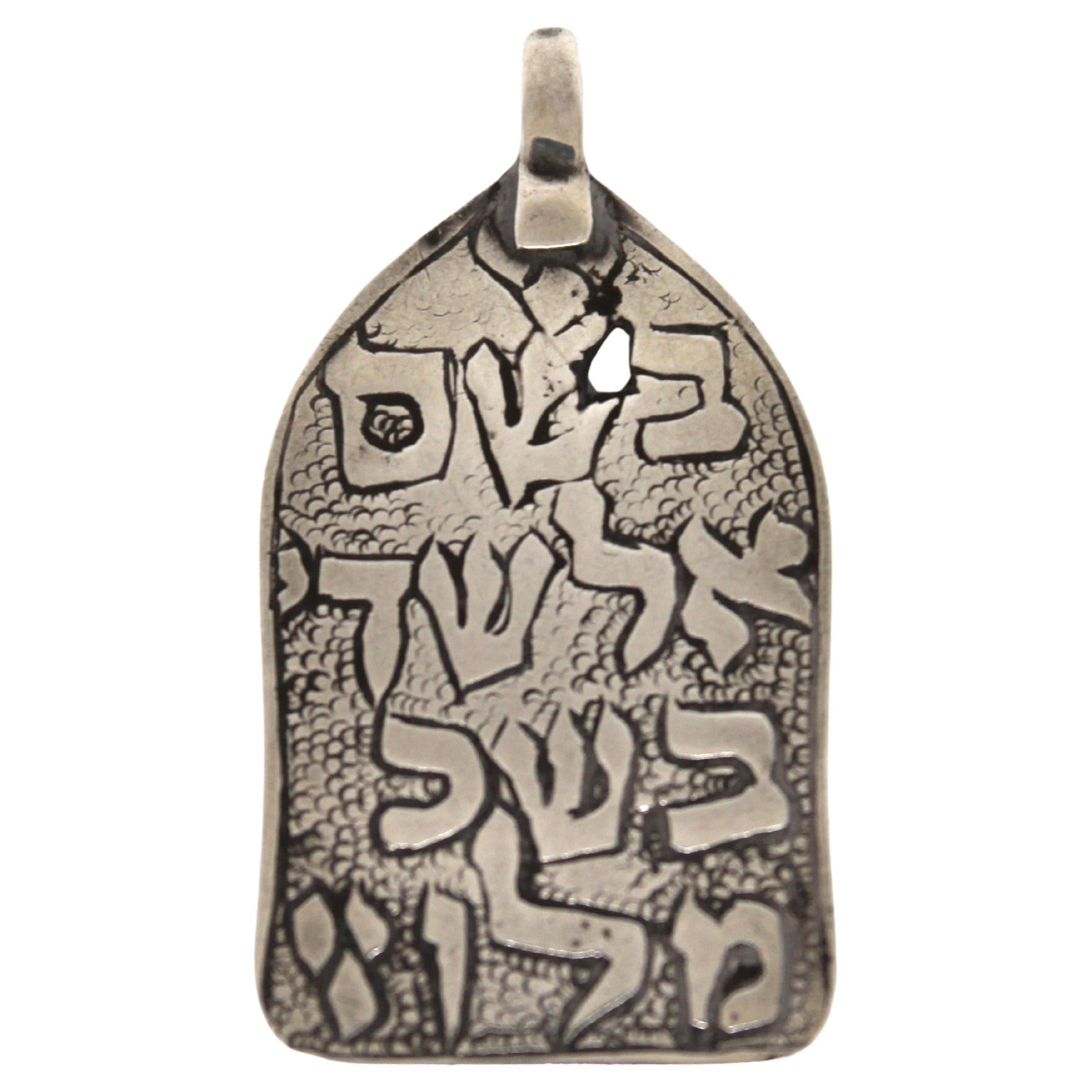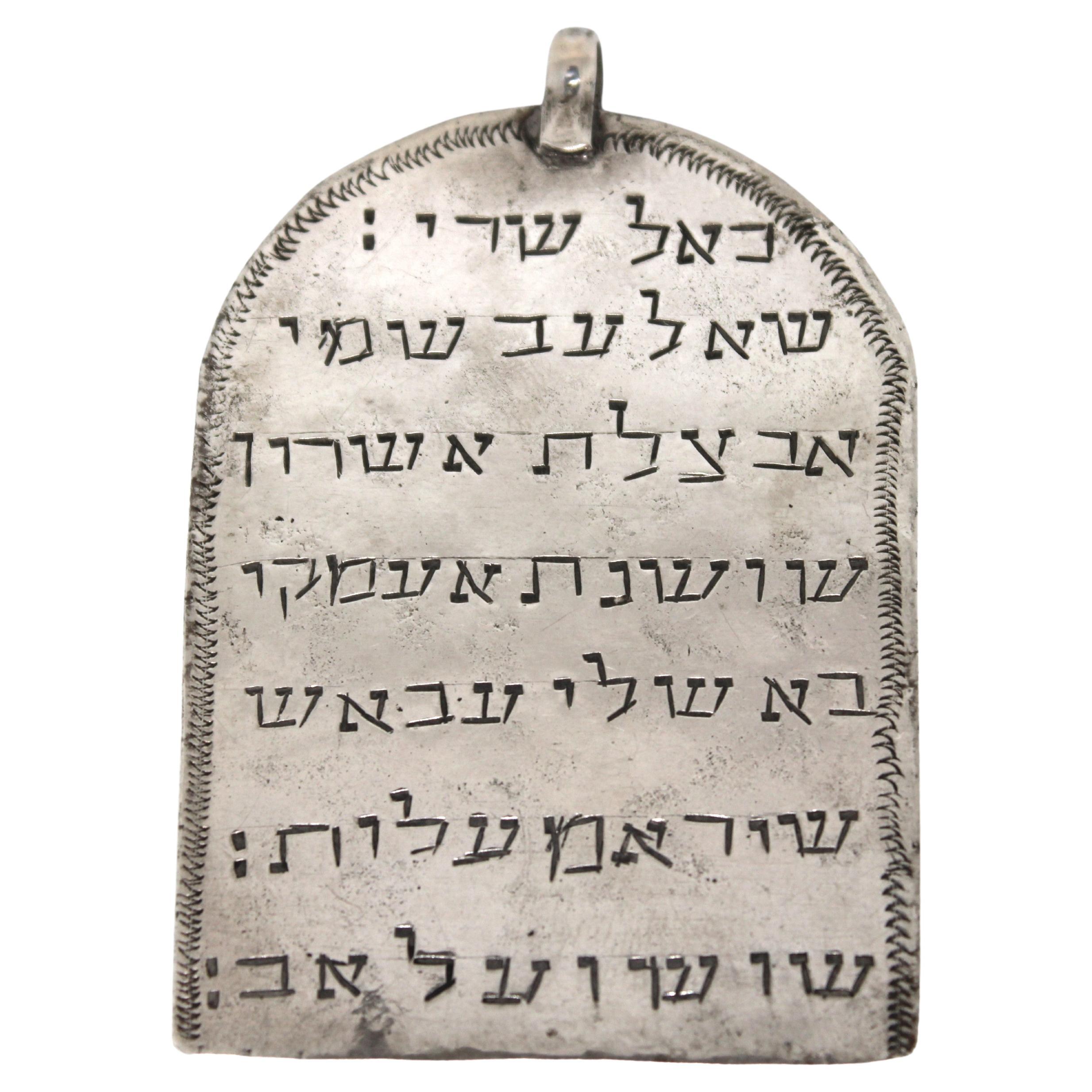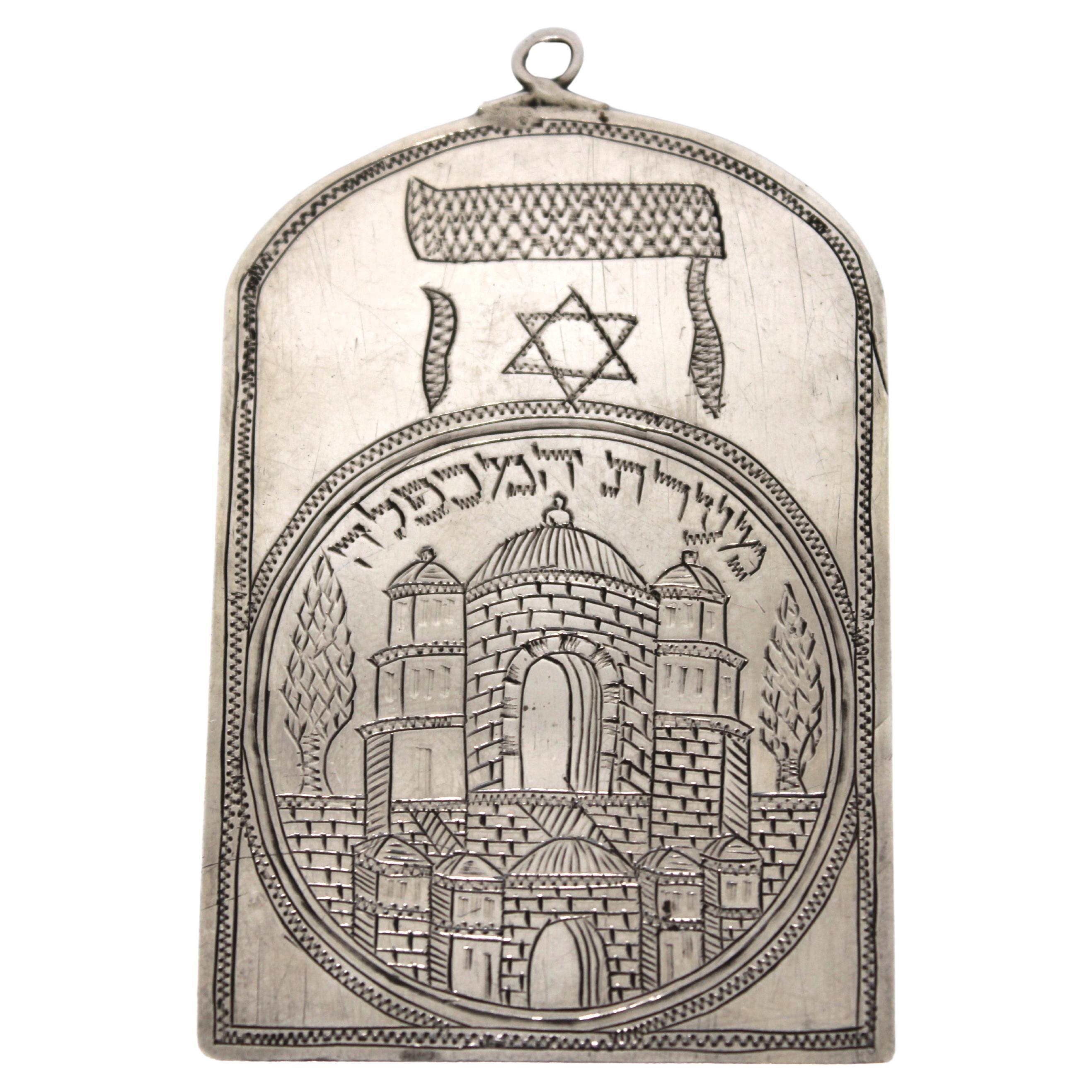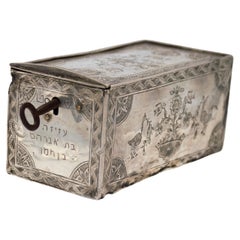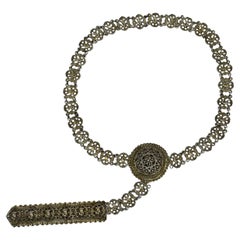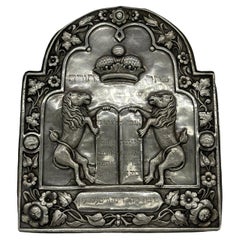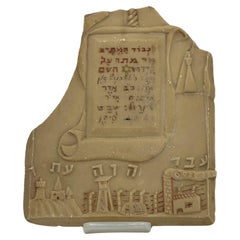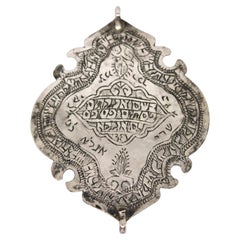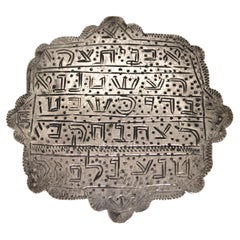Items Similar to Important 18th century Persian Jewish silver Amulet for mother and newborn
Want more images or videos?
Request additional images or videos from the seller
1 of 15
Important 18th century Persian Jewish silver Amulet for mother and newborn
$8,000
£6,070.22
€6,940.75
CA$11,173.83
A$12,423.78
CHF 6,487.01
MX$151,227.65
NOK 82,771.45
SEK 77,552.89
DKK 51,800.09
Shipping
Retrieving quote...The 1stDibs Promise:
Authenticity Guarantee,
Money-Back Guarantee,
24-Hour Cancellation
About the Item
Mysterious Amazing, 18th century silver talismanic amulet, Amulet for mother and Newborn with image of Lilith in the center made by Jews in Persia, the top of the Amulet has an amazing double eye agate cabochon to protect against evil eye. From Earliest times, man has tried to protect himself from misfortune by the use of objects Which he considered holy or otherwise (e.g., magically) potent. Amulets and Talismans are items generally worn around the neck or wrist, carried in a pocket or Purse or hung on a wall. They are meant to protect or aid those who carried or wore Them. The Hebrew word for amulet, kame‘a, has the root meaning “to bind”. Jewish Amulets are usually comprised of texts (either letters or graphic symbols) that are Inscribed on some sort of material; some may also contain plant matter or precious Stones. The texts of amulets usually include holy names that are believed to have the Ability to affect reality, along with incantations summoning angels or other magical Powers. For the most part, an amulet has a specific purpose: to ease childbirth, Facilitate recovery from illness, improve one’s livelihood, and so on, but in the Modern world many are also made for general protection.
The Amulet has a visual representation of Lilith and multiple textual formula, from the Big size we can tell this piece used to hung on a baby crib or on the wall next to the Room entrance.
The amulet textual formula include: a quotation from the Leviticus 6:22-24, וידבר יהוה אל משה לאמר. דבר אל אהרן ואל בניו לאמר כה תברכו את בני ישראל אמור להם יברכך יהוה וישמרך (And the LORD spoke unto Moses, saying: ‘Speak unto Aaron and unto his sons, saying: On this wise ye shall bless the children of Israel; ye shall say unto them: May the lord bless you and keep you); Kabbalistic permutations of the “name of God” אנקתם פסתם פספסים דיונסים (after Moshe Cordovero, Pardes rimonim 24:14) and טפטפיה בשך מלו; verses relating to Lilith אדם וחוה אברהם ושרה יצחק ורבקה יעקב ולאה חוץ לילת חוה ראשונה (adam ve-chavah avraham ve-sarah yitzchaq ve-rivqah ya’aqov ve-leah chutz lilit chavah rishonah; “Adam and Eve Abraham and Sarah Isaac and Rebecca Jacob and Leah exit Lilith the First Eve); and the acronym בפי בפע עבץ עלש (corresponding to Genesis 49:22: בן פרת יוסף בן פרת עלי-עין; “Joseph is a fruitful vine, a fruitful vine by a fountain”).
The human figure, representing Lilith, is surrounded by an inscription that completes the quotation from Leviticus featured on the top section of the amulet (the text of the Priestly Blessing, Leviticus 25-27: יאר ה פניו אליך ויחונך ישא ה פנו אליך וישם לך שלום ושמו את שמי על בני ישראל ואני אברכם; May the lord make his face shine upon you, and be gracious to you, may the lord lift his countenance on you and give you peace, So shall they put my name upon the children of Israel, and I will bless them). The inscription inside the figure states: שמירה לילד הנולד שלא יזרק לעולמא סנוי סנסנוי סמנגלף (a protection for this child, that he may not die, Sanoy Sansanoy Semangalof) and לילית אסורה בזיקים.
For a smaller and lower quality example without the double eyed agate take a look at the Israel museum Accession number:HF 0884 103/513
another example at the Magnes Museum, Siegfried S. Strauss collection, 67.1.1.3
- Dimensions:Height: 5.2 in (13.21 cm)Width: 3.4 in (8.64 cm)Depth: 0.5 in (1.27 cm)
- Materials and Techniques:
- Period:1790-1799
- Date of Manufacture:1780
- Condition:Wear consistent with age and use. good condition for something with its age and use, there is a stable crack in the lower part, running 2 inch from its 3 inch width, there are a few more small cracks to edges, the silver is all hand made so there are some cracks originally.
- Seller Location:Tel Aviv - Jaffa, IL
- Reference Number:1stDibs: LU8130240415372
About the Seller
No Reviews Yet
Vetted Professional Seller
Every seller passes strict standards for authenticity and reliability
1stDibs seller since 2023
- ShippingRetrieving quote...Shipping from: Tel Aviv - Jaffa, Israel
- Return Policy
Authenticity Guarantee
In the unlikely event there’s an issue with an item’s authenticity, contact us within 1 year for a full refund. DetailsMoney-Back Guarantee
If your item is not as described, is damaged in transit, or does not arrive, contact us within 7 days for a full refund. Details24-Hour Cancellation
You have a 24-hour grace period in which to reconsider your purchase, with no questions asked.Vetted Professional Sellers
Our world-class sellers must adhere to strict standards for service and quality, maintaining the integrity of our listings.Price-Match Guarantee
If you find that a seller listed the same item for a lower price elsewhere, we’ll match it.Trusted Global Delivery
Our best-in-class carrier network provides specialized shipping options worldwide, including custom delivery.More From This Seller
View Allextremely rare Algerian Judaica silver, jewish Dowry box early 19th century
Located in Tel Aviv - Jaffa, IL
Amazing and scarce JUDAICA object, we have here one of the most touching jewish objects we had for a long time, this small silver dowry box was made in Algeria in the early 19th century, it is all covered with symbols of jewish faith and of couples, the sliding lid has 2 flanking birds with hamsa (protective hand) on each side and a flower vase in the middle.
one side shows two flanking lions with a tree in the middle and the other side shows again two big and two small birds with a flower bowl in the middle, front side has a key hole and next to it there is the Hebrew inscription ס״ט״" which says Siman tov or in English "a good sign" it is taken from the wedding blessing, underneath the lock there is another inscription with the name ״עזיזה בת אברהם בן חמו״ which is the name of the bride, her father and her grandfathers name.
the box is full marked a lot of times with the silversmith mark, every side of the box is marked.
this box was probably ordered by the grooms family to hold the jewelry they are giving to the bride as dowry, this type of objects are rare and there are just a few of them on museum collections.
DOWRY (Heb. נְדֻנְיָה), the property a wife brings to her husband at marriage; the Yiddish equivalent, nadn, is from the same root. The custom of nedunyah became clearly defined and institutionalized only in the talmudic period. In biblical times, mohar (מֹהַר), whereby the groom bought his wife from her father (Gen. 24:53; Ex. 22:15–16; Hos. 3:2), was the accepted practice. It was then customary that the groom give the bride gifts, and that she bring certain property to her husband's home upon marriage: slaves, cattle, real estate, etc. (cf. Gen. 24:59–61; 29; Judg. 1:14ff.; I Kings 9:16). Evidence of the custom of nedunyah is to be found in Tobit (7:14; 8:21) and in the Assuan papyri (Cowley, Aramaic, nos. 15, 18). Gradually, mohar was superseded by the ketubbah custom according to which the husband merely assumed the responsibility of compensation to his wife in case he divorced her: he had to pay her 200 zuzim if she had been a virgin at the time of marriage, and 100 zuzim if a widow or divorcée (see *Ketubbah).
By talmudic times, the institution of nedunyah was prevalent; the father gave a dowry to the bride since the daughter was excluded from paternal inheritance. Fifty zuzim (equivalent to the worth of 180 grams of silver) was the minimum amount a father was obliged to give to his daughter (Ket. 6:5). Parents usually gave much more, according to their social standing. Community funds provided the dowry for an orphan or a very poor girl (ibid.; cf. Sh. Ar., YD 251:8). In case of her father's death, the brothers of a minor girl were obliged to give her the minimum dowry, and the court estimated how much her father would have given her above the minimum dowry. The sum was then taken out of the father's estate and given to the daughter upon majority (Ket. 6:6; 68a–69b). In the absence of such an estimate, each daughter was entitled to receive one-tenth of the value of her father's estate in money, or in valuables (Yad, Ishut, 20:4–7; Sh. Ar., EH 113:4). If the father was unable or unwilling to pay the promised dowry at the betrothal ceremony, the groom could refuse to marry his bride (Ket. 13:5; Ket. 108b–109a). Insistence on exact payment of the promised dowry, however, was frowned upon by later rabbinic authorities (Rema to Sh. Ar., EH 2:1). In certain communities it was customary for the groom's father to make a dowry contribution equal to that of the bride's father (Ket. 102b). The dowry, whether given in real estate, slaves, money, or chattel was recorded in the marriage contract (the ketubbah) and in some instances one-third or one-fifth of the actual value of the dowry was added to the sum mentioned in the ketubbah. Based upon a decree enacted by *Simeon b. Shetah (first century C.E.), the Talmud ruled that the husband and his entire property were liable for compensation as stipulated in the ketubbah, either in case he died (when she collected the sum specified in the ketubbah from the heirs) or in case he divorced his wife (Ket. 82b). For the status of the dowry and the husband's rights and obligations, see below. The rabbinic enactments (Takkanot Shum) by R. Jacob *Tam and by the rabbinic synod of the communities of Speyer, Worms, and Mainz (Germany) stipulated that if a woman died...
Category
Antique Mid-19th Century Algerian Tribal Art
Materials
Silver
Important and rare jewish silver Sivlonot /wedding belt, Frankfurt 1707-1723
Located in Tel Aviv - Jaffa, IL
Important and rare Sivlonot belt, gilded silver, made by the famous silversmith Johann Mathias Sandrat active in 1707-1723 in Frankfurt, Germany. this JUDAICA object is a museum piece and An almost identical belt with a replaced buckle is exhibited in the Israel museum and came from the important Feuchtwanger Collection, purchased and donated by Baruch and Ruth Rappaport, Geneva.
the belt also bears 2 Christies auction stickers with the number 120, probably lot # 120, indicating it was sold in one of their auction rooms at some point.
Sivlonot (wedding) belt:
In Rabbinic literature, sivlonot refers to gifts the groom gave his wife-to-be. Among German Jews...
Category
Antique Early 18th Century German Sterling Silver
Materials
Gold Plate, Silver
Russian silver torah shield, judaica, Michael Karpinsky, Saint Petersburg, 1835
Located in Tel Aviv - Jaffa, IL
Rare and exceptional example of early russian Judaica, this torah shield or tas is made From 84 silver, has the marks of the city of saint Petersburg, together with the makers Mark of Michael Karpinsky and the date of 1835, Judaica objects from Russia is very rare, Especially from this early date, saint Petersburg jewish community was very small Because of the Jewish settlement was largely restricted. Under Tsar Alexander II upper Class Jews fitting certain criteria were allowed to live in the city, and many other Jews Who did not fit these categories settled illegally.
This was is decorated with two flanking lions with the two tablets of stone on which the Ten Commandments were engraved on, the 10 commandments are engraved in Hebrew On this example as long as the two words "torah" and "crown" on the two sides.
On the lower part there is the inscription with the donors name which is "Dina Whitenbarch" in Hebrew. the silver work on this was is just exceptional and deep.
The crown on the top of the lions is the Russian crown.
The back part has two welded silver loops used for hanging the shield on the torah.
Measurements :
Height : 23 cm / 9 inch
Width : 19 cm / 7.4
Jews of saint Petersburg:
The history of the Jews in Saint Petersburg (formerly known as Petrograd and then Leningrad) dates back to the 18th century and there is still a Jewish community in the city Today...
Category
Antique 1830s Russian Neoclassical Revival Sterling Silver
Materials
Silver
Historic Rare Carved memorial plaque made by Jewish internee in Cyprus, 1948
Located in Tel Aviv - Jaffa, IL
super rare and historic example of Cyprus stone carving, made by jewish holocaust surviver that was Detained at the Internment camps in Cyprus, just 3 years after the holocaust. this piece is very unusual, most of this carvings shows us aspects of living in the Refugee camps or zionist views of israel, sometimes they even made judaica objects like menorahs Or Candlesticks, but its rare to find memorial plaques such as the example in front of us, the plaques was Damaged In the way to israel and two pieces from the upper section were broken off, the middle part of the Plaque shows a Scroll shaped memorial plaque with the inscription : "for the dead who died on the name of god" In red color, the middle has a yellow star carved and painted, just like the yellow star jewish...
Category
Vintage 1940s Cypriot Antiquities
Materials
Soapstone
Rare "Safed" kiddush cup, late 19th century Poland/ Eretz ISRAEL
Located in Tel Aviv - Jaffa, IL
This 84 silver cup was made in Europe, in Poland or parts of Poland that are in modern Russia in the 19th century, the interesting and important in this cup types is that they were s...
Category
Antique 1890s Israeli Sterling Silver
Materials
Silver
Rare early Bezalel Jerusalem JUDAICA etched brass garden of eden plate
Located in Tel Aviv - Jaffa, IL
very rare Bezalel Jerusalem plate , this amazing plate has the best subject And artistic Design i have seen in a lot of years, the plate has 5 different scenes from the story Of Adam And Eve in the garden pf Eden.
On the middle of the plate the is an Hebrew inscription, it is parts from the 5 lines that describe The 5 scene on the plate:
"וַיִּ֩יצֶר֩ אֶת־הָֽאָדָ֗ם עָפָר֙ מִן־הָ֣אֲדָמָ֔ה"
"And the Lord God formed man of dust from the ground"
"לֹא־ט֛וֹב הֱי֥וֹת הָֽאָדָ֖ם לְבַדּ֑וֹ"
"And the Lord God said, "It is not good that man is alone"
"'וַיִּֽהְי֤וּ שְׁנֵיהֶם֙ עֲרוּמִּ֔ים"
"Now they were both naked"
"וַתִּקַּ֥ח מִפִּרְי֖וֹ וַתֹּאכַ֑ל וַתִּתֵּ֧ן גַּם־לְאִישָׁ֛הּ"
"She took of its fruit, and she ate, and she gave also to her husband"
"וַיְגָ֖רֶשׁ אֶת־הָֽאָדָ֑ם וַיַּשְׁכֵּן֩ מִקֶּ֨דֶם לְגַן־עֵ֜דֶן אֶת־הַכְּרֻבִ֗ים וְאֵ֨ת לַ֤הַט הַחֶ֨רֶב֙ הַמִּתְהַפֶּ֔כֶת לִשְׁמֹ֕ר אֶת־דֶּ֖רֶךְ עֵ֥ץ הַֽחַיִּֽים:"
"And He drove the man out, and He stationed from the east of the Garden of Eden the cherubim and the blade of the revolving sword, to guard the way to the Tree of Life."
This rare plate is fully marked on the back "BEZALEL JERUSALEM" in Hebrew, the Jerusalem Mark is a bit worn but it is present, on the top of the mark there is the number 522 which is Probably the model number, this plate was mad on the early 1910s or even earlier and it is one of Bezalel earliest works, it is not known who is the artist but the artistic style is typical of Reuben Leaf Lipschitz, he was working in Bezalel in 1912-1916 and was the manager of the etching Department in this time frame, in 1916 he moved to the USA to escape joining the ottoman army in ww1. he stayed in the USA and became a graphic designer who designed and decorated Synagogues he also made graphic designs a illustrations to Hebrew books...
Category
Vintage 1910s Israeli Arts and Crafts Decorative Dishes and Vide-Poche
Materials
Brass
You May Also Like
Antique Iranian Silver Amulet – Fine Judaica from Persia
Located in New York, NY
This exceptional antique silver amulet from Iran exemplifies the refined craftsmanship and spiritual depth of Persian Jewish heritage. Shaped in an elegant, lobed diamond form with delicately contoured edges, the amulet is engraved with intricate detail, reflecting both artistic sophistication and religious devotion.
At the center, a stylized cartouche is inscribed with Hebrew text, likely invoking divine names or protective blessings — a hallmark of traditional Jewish amulets. Surrounding the central panel, a beautifully flowing engraved border in the form of a pointed arch or mihrab motif lends the piece a sacred architectural presence, often interpreted as a symbolic gateway to divine protection. Further floral and foliate elements are engraved into the design, subtly blending nature with mysticism.
Additional Hebrew inscriptions encircle the inner medallion and appear along the edges, each rendered in clean, carefully etched lines. The amulet features four suspension loops — one at each cardinal point — suggesting it may have once been sewn onto clothing, hung in a home, or worn as a protective charm close to the body.
Rich in symbolism and cultural meaning, this rare Iranian silver...
Category
Early 20th Century Persian Sterling Silver
Materials
Silver
An Iranian Silver Amulet, Antique Judaica from Iran
Located in New York, NY
This striking antique silver amulet from Iran is a beautiful example of Persian Jewish craftsmanship. Its scalloped, shield-like form is meticulously ha...
Category
Early 20th Century Persian Sterling Silver
Materials
Silver
An Iraqi Large Silver Amulet, Fine Antique Judaica from Iraq
Located in New York, NY
This exceptional and unusually large silver amulet from Iraq stands out as a powerful artifact of Jewish mysticism and personal devotion. Crafted with great care, the amulet features...
Category
Early 20th Century Iraqi Sterling Silver
Materials
Silver
A North African Silver Amulet, Antique Judaica from North Africa
Located in New York, NY
This exquisite antique silver amulet from North Africa is a fine example of regional Judaica, rich in spiritual significance and traditional craftsmanship. Small and tablet-shaped, t...
Category
Early 20th Century African Sterling Silver
Materials
Silver
Antique Iraqi Judaica Silver Amulet with Kabbalistic Inscriptions
Located in New York, NY
This rare antique Iraqi amulet, tablet-shaped and crafted from silver, embodies the deep spiritual heritage of Middle Eastern Judaica. Its elegant form is framed with a beautifully e...
Category
Early 20th Century Iraqi Sterling Silver
Materials
Silver
A Silver Amulet, Tzefat Circa 1890
Located in New York, NY
Rare Silver Amulet, Tzefat (Safed), Circa 1890
This extraordinary silver amulet, crafted in the sacred city of Tzefat circa 1890, is a rare and important artifact of Jewish devotion...
Category
Antique 1890s Israeli Sterling Silver
Materials
Silver
